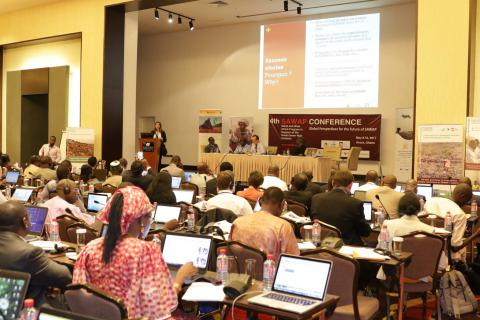Posted on August 13, 2017 by Mariangela
Answering the needs for Sahel and West Africa regions
On the theme “Global perspectives for the future of SAWAP”, the city of Accra (Ghana) became the centre of discussion for topics regarding the Sahel and West Africa Program (SAWAP) in support of the Great Green Wall when the 4th SAWAP Conference was held from 8-10 May 2017.
The three-day conference brought together one hundred participants from the twelve SAWAP countries (Benin, Burkina Faso, Ethiopia, Ghana, Mali, Mauritania, Niger, Nigeria, Senegal, Sudan, Chad and Togo). Together with partners implementing projects in the SAWAP countries, they discussed how to ensure the coherent implementation of the activities that support sustainable land and water management projects and how to capitalise the results achieved in the implementation of the SAWAP program to address land degradation. They looked together into the future of the program in order to maintain and strengthen the achievements of recent years.

One hundred participants including from the twelve SAWAP countries attended to discuss about the global perspectives for the future of SAWAP programme (© OSS)
The conference was organised by the Permanent Inter-States Committee for Drought and Desertification Control in the Sahel (CILSS) with support from the International Union for the Conservation of Nature (IUCN), the Sahara and Sahel Observatory (OSS), and the World Bank.
The EO4SD – Agriculture and Rural Development cluster, in cooperation with the Sahara and Sahel Observatory (OSS), was present at the event (through the project lead eLEAF) in order to introduce how multi-scale EO services for land degradation reveal the status and changes of the environment in a consistent and repeatable manner at a wide range of spatial and temporal changes.
The Agriculture and Rural Development cluster was invited due to its contribution to the BRICKS project (Building Resilience through Innovation, Communication and Knowledge Services). BRICKS is a regional project, implemented by OSS, that connects the 12 national SAWAP projects. It provides opportunities for south-south learning; using monitoring and evaluation (M&E) tools, geospatial services, best practices, peer review; and portfolio-wide communication.
Annemarie Klaasse from eLEAF contributed to the OSS moderated session “Environmental monitoring in SAWAP projects” by presenting EO4SD’s innovative, low-cost remote sensing solutions to improve project results reporting, investment targeting and project management performance with case studies from Ethiopia and Burkina Faso. A multi-scale land degradation service was proposed, complying to Key Performance Indicator 2 (changes in vegetation cover in targeted areas) and SDG indicator 15.3.1 (proportion of land that is degraded over total land area. The service combines open data available at large scale with tailor-made solutions to monitor hotspots at local scale. Examples showed satellite derived data and information products on land productivity (vegetation cover, biomass production), land cover change, and carbon stocks (produced by OSS).
The event also demonstrated that different projects shared experiences and knowledge through the presentation of studies and success stories.
The session was followed on Twitter by numerous organisations by using the hashtag #sawap2017
